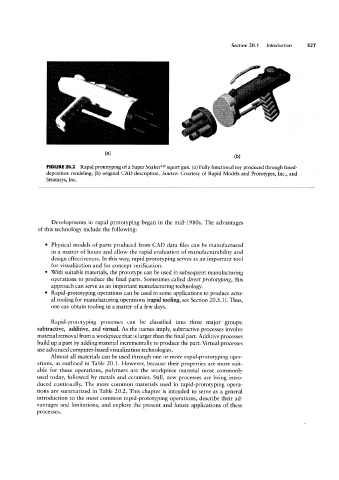Page 547 - 04. Subyek Engineering Materials - Manufacturing, Engineering and Technology SI 6th Edition - Serope Kalpakjian, Stephen Schmid (2009)
P. 547
Section 20.1 Introduction 52
(H) (D)
FIGURE 20.2 Rapid prototyping of a Super Soakerm squirt gun. (a) Fully functional toy produced through fused-
deposition modeling; (b) original CAD description. Source: Courtesy of Rapid Models and Prototypes, Inc., and
Stratasys, Inc.
Developments in rapid prototyping began in the mid-1980s. The advantages
of this technology include the following:
° Physical models of parts produced from CAD data files can be manufactured
in a matter of hours and allow the rapid evaluation of manufacturability and
design effectiveness. In this way, rapid prototyping serves as an important tool
for visualization and for concept verification.
° With suitable materials, the prototype can be used in subsequent manufacturing
operations to produce the final parts. Sometimes called direct prototyping, this
approach can serve as an important manufacturing technology.
° Rapid-prototyping operations can be used in some applications to produce actu-
al tooling for manufacturing operations (rapid tooling, see Section 20.5.1). Thus,
one can obtain tooling in a matter of a few days.
Rapid-prototyping processes can be classified into three major groups:
subtractive, additive, and virtual. As the names imply, subtractive processes involve
material removal from a workpiece that is larger than the final part. Additive processes
build up a part by adding material incrementally to produce the part. Virtual processes
use advanced computer-based visualization technologies.
Almost all materials can be used through one or more rapid-prototyping oper-
ations, as outlined in Table 20.1. However, because their properties are more suit-
able for these operations, polymers are the workpiece material most commonly
used today, followed by metals and ceramics. Still, new processes are being intro-
duced continually. The more common materials used in rapid-prototyping opera-
tions are summarized in Table 20.2. This chapter is intended to serve as a general
introduction to the most common rapid-prototyping operations, describe their ad-
vantages and limitations, and explore the present and future applications of these
processes.

